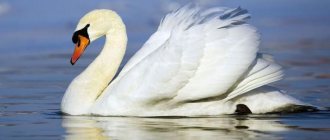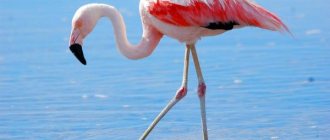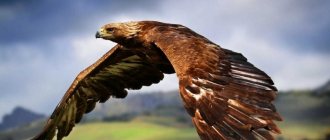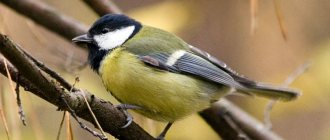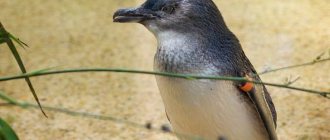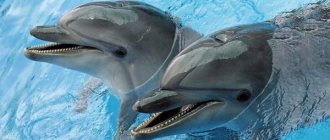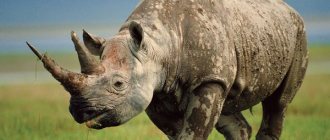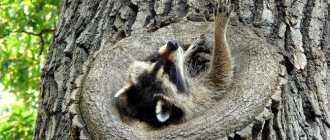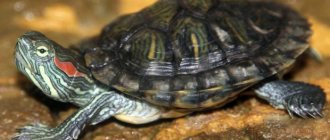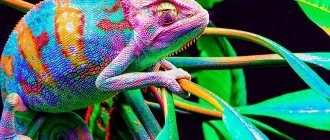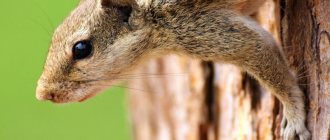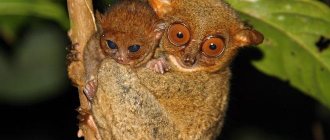| Latin name: | Pelecanus |
| English name: | To be confirmed |
| Kingdom: | Animals |
| Type: | Chordata |
| Class: | Birds |
| Squad: | Pelicaniformes |
| Family: | Pelicans |
| Genus: | Pelicans |
| Body length: | 130-180 cm |
| Wing length: | 68-77 cm |
| Wingspan: | 180—350 cm |
| Weight: | 7000—14000 g |
Description of the bird
Pelican eats fish photo
Pelican is the largest bird in its order: its body length is from 130 to 180 cm, weight from 7 to 14 kg. The appearance is special and unique: a massive body with large wings, short thick legs with wide membranes between the toes, and a short rounded tail. The neck is long. The beak is long, reaches 47 cm in length, hooked at the end. Under the beak there is a bag made of leather, which can stretch well and is used by the bird to catch fish. The plumage of pelicans is loose and does not fit tightly to the body. Feathers get wet very quickly, often birds seem to “squeeze” them out with their beaks. The color of the plumage is light - white, grayish, often with a pink tint. The flight feathers on the wings are dark. The beak and unfeathered areas of the face are brightly colored, especially during the nesting season. A tuft of feathers is visible on the back of the head. Females are smaller and duller than males. The color of young pelicans is dark brown or gray. Pelicans are generally quiet and silent birds, and only during nesting do they emit a characteristic dull roar.
Pelican nutritional features
— Advertising —
Pelican in flight photo
The basis of the pelicans' diet is fish, which the birds catch by lowering their heads into the water and grabbing prey that has risen to the surface with their beaks. The pelican's beak is very sensitive; it is with its help that the bird finds its food in the water column. The beak has a downward-curved hook that helps hold slippery prey. When a fish is caught in its beak, the pelican closes it and presses it to its chest, while the fish turns its head down towards the pelican's throat, after which the bird swallows the prey, jerking its head sharply. The pelican never uses the throat pouch to store food; it serves only to temporarily hold it. Pelicans, inhabitants of salty bodies of water, can use it to collect rainwater for drinking. Pelicans hunt alone, but more often they gather in flocks, sometimes very large. Such a group of pelicans surrounds a school of fish, drives it aground, for which it beats its wings on the water and then each pelican catches its prey. Sometimes cormorants, gulls, and terns join in such a joint hunt. A pelican eats more than a kilogram of fish per day. And, for example, the Australian pelican consumes it in quantities of up to 9 kg. In addition to fish, pelicans also feed on crustaceans, tadpoles and adult amphibians, as well as small turtles. Pelicans willingly accept food from people. When there is a lack of food, pelicans can catch gulls and ducklings or fight off prey from other birds.
Features of character and lifestyle
Pelicans have a close relationship with their relatives; most of their life activities take place in group conditions. Birds live, breed, migrate and obtain food while living in one large colony. Searching for food through fishing does not take much time for birds: most birds finish their “breakfast” by about 9 am. The birds spend the rest of their time bathing and preening their feathers. This occurs in the territories of small islands and sandbanks.
Recommended by topic
Blackbirds Woodpecker Heron
Pelicans bathe in the following way. They tilt their head and body towards the water, beginning to flap their wings. A bird opens its beak or spreads its wings when its body temperature increases to implement the function of thermoregulation.
The large body mass of pelicans makes their take-off quite a difficult procedure. The pelican needs to actively flap its wings for a long time while on the water surface before it can take off. However, if the bird has already risen up, it will be able to organize a confident flight. Thus, pelicans are able to stay in the air for 24 hours without a break, covering up to 500 km in one flight.
The flight speed of birds is about 55 km/h at a distance of 3000 meters above sea level. During flight, pelicans are able to bend their neck so that the head is between the shoulders, and the massive beak is held with the help of the neck. Since the anatomical features of the structure of birds do not allow them to constantly flap their wings, during the flight they alternate phases of a long dive with subsequent flapping.
All representatives of this family are divided into two large groups. Representatives of the first group include species that build ground nests. These include individuals with predominantly white plumage. Representatives of the second group choose trees or sea cliffs for nesting. This includes birds that have gray-brown plumage.
Bird distribution
Pelican distribution map photo
Pelicans are common on all continents except Antarctica, in temperate and tropical climate zones. Seasonal migration depends on the specific places of residence of a particular population. To live, these birds choose shallow sea waters, shallow fresh and salt lakes, and the mouths of large rivers.
Common Pelican Species
Australian pelican (Pelecanus conspicillatus)
— Advertising —
Australian pelican (Pelecanus conspicillatus) photo
Australia's largest flying bird. Wingspan from 2.5 to 3.5 m. Weight from 5 to 6.8 kg (the record is 8.2 kg); body length 1.6-1.9 m; beak length 40-50 cm. The leather bag under the beak holds from 9 to 13 liters of water. The lifespan of the Australian pelican is 10-25 years. The species is distributed throughout Australia, New Guinea and western Indonesia. This pelican lives both in fresh water bodies and on sea coasts, in swamps, coastal islands and in floodplains. The Australian pelican can fly long distances to find food and nesting sites.
Dalmatian pelican (Pelecanus crispus)
A flock of Dalmatian pelicans photo
Body length up to 180 cm. Wingspan about 3.5 m. Weight of adult birds from 9.0 to 14.0 kg. The color of the plumage is mainly white, the back is light gray on top. The flight feathers on the wings are black. The throat sac is light yellow in color, becoming reddish-orange during the mating season. Paws are gray. In young animals, the curl of the “mane” is weak, brownish spots are noticeable on the back, the legs and beak are black. The downy chick is white with a brownish-black beak. Males and females are colored the same. The Dalmatian pelican lives over a wide area from the Balkan Peninsula to Mongolia and the upper reaches of the Yellow River. Winters in Iraq, Pakistan, northwestern India and southern China, and occasionally on the southern shores of the Caspian Sea. For life it chooses lakes, lower reaches and river deltas overgrown with grasses.
American brown pelican (Pelecanus occidentalis)
American brown pelican (Pelecanus occidentalis) photo
The smallest of the pelicans: body length does not exceed 140 cm, and weight up to 4.5 kg. It also differs from other species in the brown color of its plumage with a white head and an ocher-yellow crown. The beak is gray, the throat pouch and paws are black. The species nests on the sea coasts of the Atlantic (from Nova Scotia to the Antilles) and Pacific oceans (from British Columbia to the islands off the coast of Chile). It does not fly inside continents.
American white pelican (Pelecanus erythrorhynchos)
American white pelican (Pelecanus erythrorhynchos) photo
A large bird with a body length from 130 to 165 cm, a wingspan of 2.4-2.9 m. Weight ranges from 4.5-13.5 kg, on average from 6 to 8 kg. The plumage color is almost entirely bright white, with black flight feathers that are visible only in flight. The beak is large, dark pink in color, with a throat pouch on the lower jaw. Paws are orange. In the mating season, the beak and legs become bright orange, a crest appears on the back of the head, and a vertical, flat, triangular-shaped orange crest appears on the upper jaw. The species is distributed in North America, Canada and the USA, where it lives in rivers, lakes, swamps and sea coasts.
Pelicans living in our country
The pink pelican nests in the Black Sea region, on the coast of the Caspian Sea, in Altai and Kazakhstan. Its peculiarity is that the feathers are pinkish in color with a black border around the edge. Its legs are also pink, and the sac under its beak is yellow. There is also a buffy spot on the chest. This bird has a high crest of pointed feathers on its head. In this way, it is similar to another species that lives in our country - the Dalmatian pelican, which is larger and does not have a pink color. Its feathers are white with a gray tint, and its paws are also gray. They called it that because the feathers on its head and neck are slightly curled and form something like a mane. These pelicans are an endangered species and are protected.
Pelican breeding
To reproduce, pelicans create large colonies of up to 40,000 individuals on islands or coasts. Birds begin nesting at any time of the year, depending on climatic conditions. Pelican pairs form for just one season. During the mating season, the color of the beak and throat pouch of pelicans changes. The front half of the beak turns bright pink with isolated blue areas, and the skin of the pouch near the throat becomes chrome yellow. A diagonal black stripe appears from the base of the beak to its top. These color changes last until the eggs begin to hatch.
Mating of pelicans precedes a long courtship. Two to eight males follow one female around the colony, shaking their open beaks to attract her and threatening each other. Males also pick up small objects, sticks or small dried fish, and throw them into the air, and then catch them. They repeat such “tricks” many times. Also, during courtship, pelicans often clap their beaks, emitting a kind of “applause,” while fast waves run through the throat sac, as if across a flag in a strong wind.
Gradually, the gentlemen leave the female one by one, and after a chase through land, water and air, only one male remains near her, and the female leads him to the site of building the nest. Large species of pelicans build nests on the ground. The nest on the ground is a hole dug by the female and covered with branches and old feathers. Small pelicans can nest in trees that grow near bodies of water.
The nest is always built by the female, and the male brings material for it. Several pairs of pelicans can build a common nest. In one clutch, the female has from 1 to 3 blue or yellow eggs, which she lays at intervals of 2-3 days. Both parents are involved in incubation; it begins from the moment the first egg appears and lasts about 35 days. Both the male and female also feed the chicks. The first chick to hatch is usually larger than the others. It receives more food from its parents and may even attack and kill its brothers and sisters. Newborn pelican chicks have a large beak, bulging eyes, and are naked. Downy plumage appears on the 10th day of life. The chicks leave the nest at the age of 10 to 20 days, and form homogeneous groups of up to 100 individuals, a kind of “nursery”. There they spend up to two months, and after that they acquire complete independence.
Nesting grounds
Pelicans live in flocks of several hundred pairs. They also live in groups during the interbreeding period. Other species of coastal birds often live near them.
Pelicans do not have a clear division of responsibilities. But together they feel much safer. Pelicans are very friendly birds. Conflicts between them are quite rare. Only sometimes pelicans fight with their beaks for delicacies or branches for construction.
Despite their considerable weight, these birds fly well. True, in order to soar into the air, they need a decent run-up. And they can float in the air only if there are air currents. Since pelicans are migratory birds, they can fly long distances. At the same time, they replace several leaders, each of whom sets the pace for the flight of the entire flock.
Interesting facts about the bird
Pelican feeding from its beak photo
- Dalmatian and gray pelicans are listed as vulnerable species on the International Union for Conservation of Nature Red List. The main reason for the decline in pelican populations is considered to be the widespread use of DDT and other strong pesticides in the middle of the last century. Birds received pesticides through their food and, as a result, their fertility decreased. Since 1972, the use of DDT in the United States and several other countries was banned and pelican populations began to recover. In captivity, pelicans live up to 20 years or more, but reproduce reluctantly.
- Pelicans are characters in many legends and fairy tales, which are based on myths about the bird’s self-sacrifice for the sake of its offspring. So, in the Middle Ages, this bird was a symbol of Jesus Christ. And in European heraldry, the pelican is a symbol of selfless parental love, since for a long time it was believed that the bird tears its chest with its beak and feeds the hungry chicks with its own blood. The pelican is the symbol of the Pedagogical University of Russia. A bird feeding its chicks is depicted on the gate at the entrance. The prize for the best teacher of the year in Russia is the Crystal Pelican figurine. And in Scandinavia, the pelican is the emblem of donors.
- The pelican is also an important alchemical symbol, as its beak is shaped like a retort.
- The Albanian 1 lek coin is decorated with the image of a pelican.
Population and species status
The total number of pelicans living on our planet is constantly decreasing, which is associated with a number of negative factors. The use of various chemicals by humans has a rather negative effect on these birds, which negatively affects the fertility of these birds, as well as other aspects of health.
Australian pelicans found themselves in fairly comfortable conditions, as did other pelican species except the Gray Pelican, which found themselves on the verge of vulnerability. Pelicans of the species "Pelecanus thagus" have also suffered from various negative influences and are therefore considered a vulnerable species.
